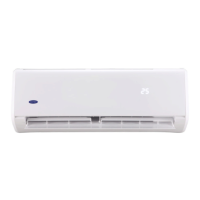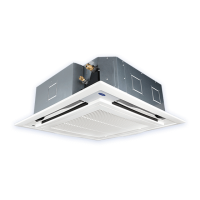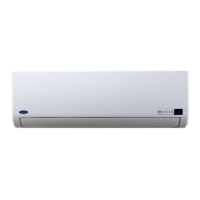Do you have a question about the Carrier Xpower Series and is the answer not in the manual?
Only certified professionals should install, repair, or service the equipment to avoid damage or hazards.
Follow all safety instructions carefully to prevent hazards like leaks, electrical shocks, and fires during installation.
Avoid installing the unit in locations with petrol, salty air, oil pollution, or strong electromagnetic waves.
Check for damage, verify model/specifications, and ensure all accessories are present after unpacking.
Ensure correct pipe diameter, nitrogen filling before welding, and heat insulation.
Perform airtight test with specified pressure before vacuum extraction.
Guide to selecting the correct outdoor unit based on HP and the number of indoor units.
Provides detailed dimensions for 8-12 HP and 14-22 HP outdoor units.
Criteria for choosing an optimal, dry, well-ventilated, and safe location for the outdoor unit.
Guidelines for constructing a solid, level base to support the outdoor unit and prevent noise.
Illustrates screw bolt positions and dimensions for mounting the outdoor unit base.
Shows how to center connective pipes for proper installation.
Explains sequence for placing multiple units and setting master/slave configurations.
Specifies required clearances around the outdoor unit for maintenance and airflow.
Provides diagrams for optimal outdoor unit layout in single or multiple rows.
Instructions for installing snow sheds in snowy areas to prevent malfunction.
Steps for safely removing front posts and the upper panel for access.
Identifies and explains the function of various valves on the unit.
Instructions for mounting air deflectors, including dimensions and static pressure considerations.
Further details on air deflector mounting, including notes on shutter angles and flexible connectors.
Pressure-airflow curves for different HP units, showing factory settings and customizable ranges.
Specifies maximum total pipe length, drop heights, and equivalent lengths for refrigerant piping.
Table detailing pipe sizes for indoor units based on capacity and joint type.
Tables specifying outdoor unit connective pipe sizes based on HP and piping length.
Guide to selecting multi-connection pipes for outdoor units based on quantity and pipe diameter.
Provides practical examples for selecting pipe sizes for specific system configurations.
Instructions for cleaning pipes with nitrogen before connecting.
Detailed steps and precautions for performing the gas tightness test using nitrogen.
Procedure for using a vacuum pump to remove air and moisture from the system.
Continued procedure for vacuum pump usage, including leak checks.
Formula and table for calculating and adding the correct amount of refrigerant.
Guidelines for connecting pipes between outdoor units, ensuring correct orientation and avoiding concave shapes.
Proper installation of branch joints to prevent oil accumulation in the outdoor unit.
Correct and incorrect methods for installing U-shaped branch joints to prevent faults.
Explanation of diagnostic codes and display information from the SW2 switch.
Identifies the functions of various terminals on the terminal base.
General guidelines for wiring outdoor and indoor units, including power supply and communication wiring.
Table listing electrical specifications (voltage, current, power) for different outdoor unit capacities.
Detailed caution notes and instructions for power supply, leakage protector, and manual switch.
Guidelines for selecting wire size and capacity for outdoor unit power supply based on HP and length.
Wiring diagram for connecting indoor units via a branch box.
Tables to select manual switch and fuse capacity for branch boxes based on total horsepower.
Instructions for using cable clips to secure power wires, with guidelines for stripping and fastening.
Guidelines for installing shielded control wires, ensuring proper grounding and separation from power wires.
How to correctly connect 3-core shielded signal wires between indoor and outdoor units, noting polarity.
Checklist for verifying connections, voltage, pressure tests, and vacuum drying before operation.
Steps for preparing refrigerant, system plans, and initial power-on for compressor oil heating.
Procedure for naming and recording connected systems for identification.
Details on refrigerant type (R410A), GWP, and leak check frequency based on regulations.
Precautions regarding refrigerant leakage, critical thickness, and necessary ventilation or detection systems.
Only certified professionals should install, repair, or service the equipment to avoid damage or hazards.
Follow all safety instructions carefully to prevent hazards like leaks, electrical shocks, and fires during installation.
Avoid installing the unit in locations with petrol, salty air, oil pollution, or strong electromagnetic waves.
Check for damage, verify model/specifications, and ensure all accessories are present after unpacking.
Ensure correct pipe diameter, nitrogen filling before welding, and heat insulation.
Perform airtight test with specified pressure before vacuum extraction.
Guide to selecting the correct outdoor unit based on HP and the number of indoor units.
Provides detailed dimensions for 8-12 HP and 14-22 HP outdoor units.
Criteria for choosing an optimal, dry, well-ventilated, and safe location for the outdoor unit.
Guidelines for constructing a solid, level base to support the outdoor unit and prevent noise.
Illustrates screw bolt positions and dimensions for mounting the outdoor unit base.
Shows how to center connective pipes for proper installation.
Explains sequence for placing multiple units and setting master/slave configurations.
Specifies required clearances around the outdoor unit for maintenance and airflow.
Provides diagrams for optimal outdoor unit layout in single or multiple rows.
Instructions for installing snow sheds in snowy areas to prevent malfunction.
Steps for safely removing front posts and the upper panel for access.
Identifies and explains the function of various valves on the unit.
Instructions for mounting air deflectors, including dimensions and static pressure considerations.
Further details on air deflector mounting, including notes on shutter angles and flexible connectors.
Pressure-airflow curves for different HP units, showing factory settings and customizable ranges.
Specifies maximum total pipe length, drop heights, and equivalent lengths for refrigerant piping.
Table detailing pipe sizes for indoor units based on capacity and joint type.
Tables specifying outdoor unit connective pipe sizes based on HP and piping length.
Guide to selecting multi-connection pipes for outdoor units based on quantity and pipe diameter.
Provides practical examples for selecting pipe sizes for specific system configurations.
Instructions for cleaning pipes with nitrogen before connecting.
Detailed steps and precautions for performing the gas tightness test using nitrogen.
Procedure for using a vacuum pump to remove air and moisture from the system.
Continued procedure for vacuum pump usage, including leak checks.
Formula and table for calculating and adding the correct amount of refrigerant.
Guidelines for connecting pipes between outdoor units, ensuring correct orientation and avoiding concave shapes.
Proper installation of branch joints to prevent oil accumulation in the outdoor unit.
Correct and incorrect methods for installing U-shaped branch joints to prevent faults.
Explanation of diagnostic codes and display information from the SW2 switch.
Identifies the functions of various terminals on the terminal base.
General guidelines for wiring outdoor and indoor units, including power supply and communication wiring.
Table listing electrical specifications (voltage, current, power) for different outdoor unit capacities.
Detailed caution notes and instructions for power supply, leakage protector, and manual switch.
Guidelines for selecting wire size and capacity for outdoor unit power supply based on HP and length.
Wiring diagram for connecting indoor units via a branch box.
Tables to select manual switch and fuse capacity for branch boxes based on total horsepower.
Instructions for using cable clips to secure power wires, with guidelines for stripping and fastening.
Guidelines for installing shielded control wires, ensuring proper grounding and separation from power wires.
How to correctly connect 3-core shielded signal wires between indoor and outdoor units, noting polarity.
Checklist for verifying connections, voltage, pressure tests, and vacuum drying before operation.
Steps for preparing refrigerant, system plans, and initial power-on for compressor oil heating.
Procedure for naming and recording connected systems for identification.
Details on refrigerant type (R410A), GWP, and leak check frequency based on regulations.
Precautions regarding refrigerant leakage, critical thickness, and necessary ventilation or detection systems.
| Brand | Carrier |
|---|---|
| Model | Xpower Series |
| Category | Air Conditioner |
| Language | English |












